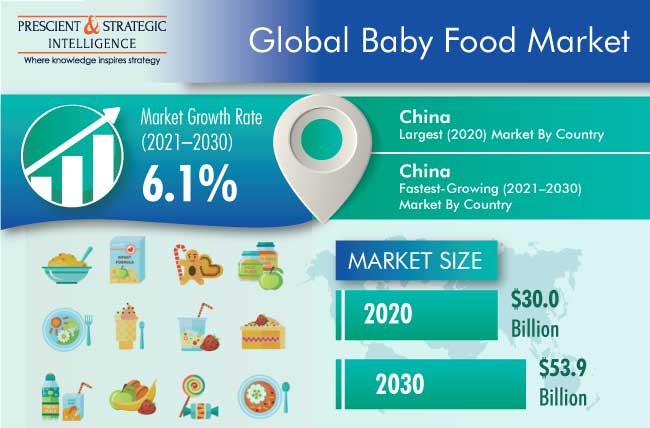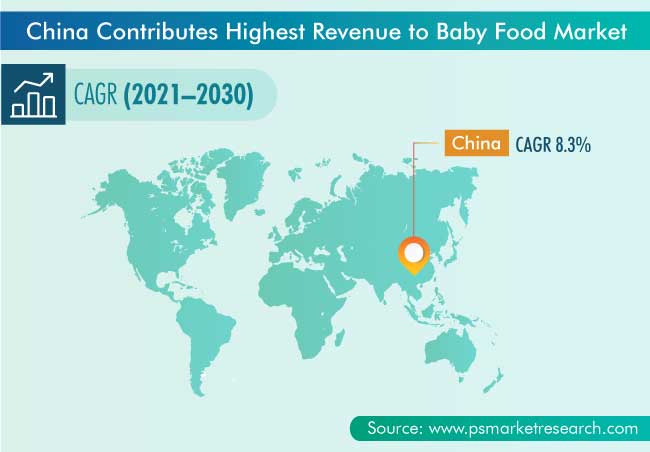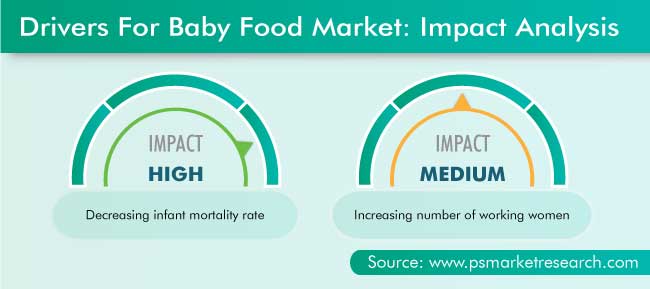Report Code: 10559 | Available Format: PDF | Pages: 247
Baby Food Market Research Report: By Product (Infant Formula, Baby Cereals, Baby Snacks, Baby Soups, Baby Pureed Food), Type (Inorganic, Organic), Distribution Channel (Hypermarkets, Supermarkets, Drug Stores, Specialty Stores, Online) - Global Industry Analysis and Growth Forecast to 2030
- Report Code: 10559
- Available Format: PDF
- Pages: 247
- Report Description
- Table of Contents
- Market Segmentation
- Request Free Sample
Market Overview
The global baby food market was valued at $30.0 billion in 2020, and it is expected to grow at a CAGR of 6.1% during the forecast period (2021–2030). This can be attributed to the increasing number of working mothers, increasing parental concerns about nutrition, decreasing infant mortality rate, surging awareness on innovative baby food products, and rising organized retail marketing activities and urbanization rate.
Despite the lockdowns implemented to ensure the safety of citizens, key companies in the market for baby food have been witnessing a high product demand during the COVID-19 period. The pandemic has made people more conscious about their and their babies’ health, as several research studies have claimed that people and children with low immunity and physical strength are more vulnerable to the disease. Parents worldwide are now more concerned about their infants’ health; therefore, investing more in organic and healthier supplements and food products for their babies.

Infant Formula Category Dominates Market due to Breastfeeding Problems among Infants
The infant formula category held the largest share in the baby food market in 2020, and it is expected to retain its position during the forecast period, based on product. This will primarily be due to the increasing incidence of lactating issues with women, which has influenced the adoption of milk-based baby food products. Moreover, breastfeeding problems with infants are a major factor behind the rising demand for infant formula.
Inorganic Category Held Larger Market Share due to Lower Cost of Such Products
The inorganic category held the larger share in the market for baby food in 2020, based on type. Moreover, it would continue to grow in the coming years, mainly due to the rising focus of industry players on increasing the production of inorganic baby food, since the production cost of organic baby food is higher, as companies face hindrances in cost-effective procurement of organic ingredients.
Online Category to Witness Fastest Growth owing to Growing E-Commerce Market
The online category is expected to witness the highest growth rate in the baby food market during the forecast period, based on distribution channel. This is attributed to the swiftly growing e-commerce market globally. Moreover, the preference of customers is shifting toward online channels, especially in the present scenario of the COVID-19 pandemic, which is leading to the rising sales of baby food via online channels, in order to avoid stepping out and, ultimately, stay safe.
Due to Rising Birth Rate, Asia-Pacific Held Largest Share in 2020
Geographically, Asia-Pacific (APAC) dominated the market for baby food in the past, and it is expected to grow at the highest CAGR in the foreseeable future. This will primarily be due to the high birth rates, increasing women workforce, growing disposable income, rising awareness of baby food products among people, and extensive research and development (R&D) by various companies in the baby food segment.

Demand for Organic Baby Food Is Key Trend
Organic and natural products are high in demand, thus a key trend in the baby food market. According to an article published in The Hindu in 2018, inorganic baby products have many synthetic ingredients, which might give rise to health problems. That is why, to provide the baby with sustainable and safe nutrition, parents are increasingly opting for organic and natural products.

Rise in Working Women Population Is Driving Market
Working women are focusing on their babies’ nutritional needs, along with their work life, and opting for processed baby foods, thus resulting in the growth of the market for baby food. According to the Office for National Statistics (ONS), 74% of the mothers in England were working as of September 2018, as compared to 69% in 2013. Moreover, according to the data provided by the Catalyst, 20.3% of the women aged 15 years and older were part of the labor force of India in 2020. Similarly, in Australia, women’s labor force participation rate stood at 61.1% in 2019.
Decreasing Infant Mortality Rate
The infant mortality rate has been decreasing due to several reasons, including improvement in sanitation and access to clean drinking water, which is leading to the growth of the baby food market. Moreover, the infant mortality rate has declined due to a decrease in female infanticides and feticides in some countries, in part due to the several measures taken by the government. According to the data provided by Worldometers, the infant mortality rate has steadily decreased from 62.91 infant deaths per 1,000 live births in 1990 to 26.05 deaths per 1,000 live births in 2020. With more infants than before, the demand consumption of baby food is surging.
| Report Attribute | Details |
Historical Years |
2015-2020 |
Forecast Years |
2021-2030 |
Base Year (2020) Market Size |
$30.0 Billion |
Market Size Forecast in 2030 |
$53.9 Billion |
Forecast Period CAGR |
6.1% |
Report Coverage |
Market Trends, Drivers, and Restraints, Segmentation Analysis, Country Breakdown, Impact of COVID-19, Companies’ Strategic Developments, Company Profiling |
Market Size by Segments |
By Product, By Type, By Distribution Channel, By Region |
Market Size of Geographies |
U.S., Canada, Germany, France, U.K., Italy, Spain, Russia, China, Japan, India, Australia, South Korea, Brazil, Mexico, Saudi Arabia, South Africa |
Secondary Sources and References (Partial List) |
Brazilian Institute of Geography and Statistics, Bureau of Statistics of China, International Growth Center, Italian National Institute of Statistics, Indian Ministry of Statistics and Programme Implementation, National Bureau of Economic Research, Organisation for Economic Co-operation and Development, Statistics Bureau of Japan, World Bank |
Explore more about this report - Request free sample
Market Players Are Involved in Product Launches and Approvals to Gain Significant Position
The global baby food market is consolidated in nature. Some of the major players in the market are Nestlé S.A., Danone S.A., The Kraft Heinz Company, Reckitt Benckiser Group plc, Abbott Laboratories, China Feihe Limited, HiPP GmbH & Co. Vertrieb KG, China Mengniu Dairy Company Limited, Hero Group, Inner Mongolia Yili Industrial Group Co. Ltd., Kewpie Corporation, DMK Deutsches Milchkontor GmbH, PZ Cussons (UK) Limited, Perrigo Company plc, and Royal FrieslandCampina N.V.
In recent years, players in the baby food industry have been involved in product launches and approvals in order to attain a significant position. For instance,
- In April 2021, The Kraft Heinz Company launched a plant-based baby food range to provide a high-quality vegan diet to babies. This range includes three types of products: Saucy Pasta Stars with beans & carrot, Potato Bake with green beans & sweet garden peas, and Risotto with chickpeas & pumpkin.
- In November 2020, Nestlé S.A. entered the frozen baby food business by launching Freshful Start, which is an organic, simple-ingredient line of foods made with vegetables and whole grains packaged in bowls. These products come in five varieties with different combinations of vegetables.
Some Key Players Operating in Baby Food Market Are:
-
Nestlé S.A.
-
Danone S.A.
-
Reckitt Benckiser Group plc
-
Abbott Laboratories
-
China Feihe Limited
-
HiPP GmbH & Co. Vertrieb KG
-
The Kraft Heinz Company
-
Hero Group
-
Inner Mongolia Yili Industrial Group Co. Ltd.
-
Kewpie Corporation
-
Royal FrieslandCampina N.V.
Market Size Breakdown by Segments
The baby food market report offers comprehensive market segmentation analysis along with market estimation for the period 2015-2030.
Based on Product
- Infant Formula
- Baby Cereals
- Baby Snacks
- Baby Soups
- Baby Pureed Food
Based on Type
- Inorganic
- Organic
Based on Distribution Channel
- Hypermarkets
- Supermarkets
- Drug Stores
- Specialty Stores
- Online
Geographical Analysis
- North America
- U.S.
- Canada
- Europe
- Germany
- France
- U.K.
- Italy
- Spain
- Russia
- Asia-Pacific (APAC)
- China
- Japan
- India
- Australia
- South Korea
- Latin America (LATAM)
- Brazil
- Mexico
- Middle East and Africa
- Saudi Arabia
- South Africa
The global baby food market was valued at $30.0 billion in 2020, and it is expected to grow at a CAGR of 6.1% during the forecast period (2021–2030).
In the baby food industry, infant formula registers the highest sales.
The market for baby food is dominated by China.
The baby food industry is driven by the increasing infant population, lactating issues in women, and growing female working population.
The market for baby food is consolidated.
Want a report tailored exactly to your business strategy?
Request CustomizationWant an insight-rich discussion with the report author?
Speak to AnalystOur dedication to providing the most-accurate market information has earned us verification by Dun & Bradstreet (D&B). We strive for quality checking of the highest level to enable data-driven decision making for you
Our insights into the minutest levels of the markets, including the latest trends and competitive landscape, give you all the answers you need to take your business to new heights
With 24/7 research support, we ensure that the wheels of your business never stop turning. Don’t let time stand in your way. Get all your queries answered with a simple phone call or email, as and when required
We take a cautious approach to protecting your personal and confidential information. Trust is the strongest bond that connects us and our clients, and trust we build by complying with all international and domestic data protection and privacy laws